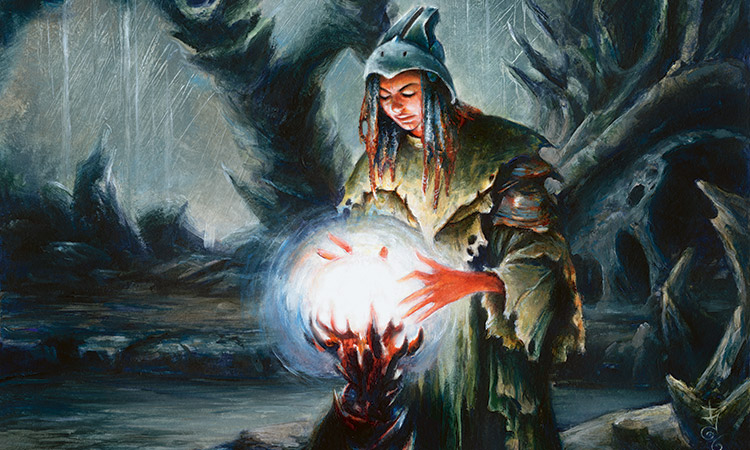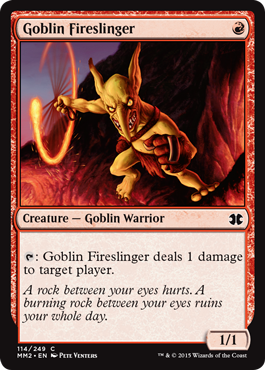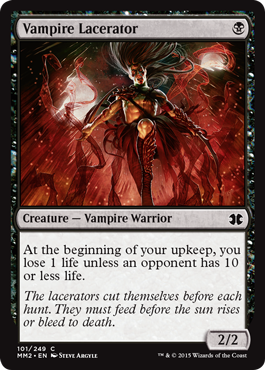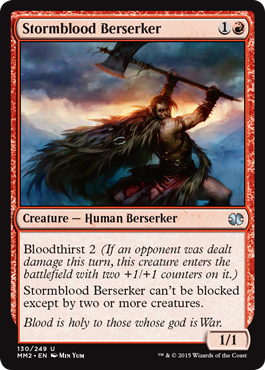Damage Racing
Typically, in Magic, we tend to think of one player being the aggressor and the other playing defense. However, role assignment can be fluid, and often times both players can utilize elements of offense and defense at the same time.
When should you be conservative? When is it time to throw caution to the wind? Today we're going to tackle the important question: What's the best way to kill an opponent who's also trying to kill you? In a few weeks, we can try out our answer using today's preview cards from Modern Masters 2015 Edition!
What is a Damage Race?
A damage race (or simply a race) is an element of Magic that shows itself when neither player is able to take firm control of the game.
Johnny is attacking Jenny. Jenny cannot effectively stop Johnny's attack. Her only course of action is to race—to try to win the game before Johnny's creatures deal her the finishing blow.
Races are most often driven by one or both players having creatures with evasion (flying, unblockable, etc.). However, the presence of anything that makes it easier to attack than to block might lead to a race. Prowess, heroic, or the threat of a combat trick are just a couple of the innumerable reasons why it might be more profitable to be attacking than to sit back and try to block.
What does a discussion of damage racing make you think of? Is it the last minutes of a hockey game where even the goalie leaves his post and tries to score? Is it an image of soldiers pouring over enemy ramparts? Han Solo and Princess Leia desperately trying to shut the Death Star's shields down before it's too late? Conceptually, a damage race might invoke the spirit of primal rage, boiling blood, and reckless abandon. Ironically, however, it can be the aspect of Magic that requires the most precision, thinking ahead, and careful planning.
It's easy for a race to come down to just a few life points in either direction. Winning a close race is about thinking ahead, squeezing every bit of value out of all of your resources, and planning things out to make sure you're on the winning side.

Careful Consideration | Art by Janine Johnston
Using Your Life Total as a Resource
We've discussed mana as a resource, cards as a resource, even things like tempo as a resource. Your life total is a resource too, though with some important differences. You can use your mana and your cards to impact the game, often in a repeatable way. Life total does not help you control the board or the flow of the game. It cannot be spent to your advantage. Sort of….
In some ways, the only meaningful life total is 0. Being at 1 life or being at 20 life doesn't impact your ability to play the game, or your control over the board. However, being at a low life total can limit your options. You must block a creature that attacks you. Perhaps even the threat of an attack can limit your options. Do you need to leave an extra blocker for fear of your opponent drawing a removal spell or a haste creature? Will it limit your ability to use your Mana Confluence or cast your Read the Bones?
Life total is a resource, but each point of life can have a very different value. Your last point of life is worth everything—you'll do whatever is in your power to protect it. On the other hand, you're thrilled if you can start the game with Llanowar Wastes and Elvish Mystic, even though it means being at 19. Against an Esper Control deck, you don't mind taking some frivolous damage, but against a Mono-Red Burn deck, every point really matters.
So how do you equate a change in your life total against a card in your hand or an advantage on the board?
Chump Blocking
To chump block means to block with a creature to preserve your life total, even though you're going to lose the creature. You generally want to avoid chump blocking when you can, especially early in the game. After all, creatures in play can generate advantages as the game goes on, whereas your life points cannot.
Everyone learns quickly that it's a bad idea to chump block an attacking Fleecemane Lion with an Elvish Mystic on the third turn. The Elvish Mystic still has work to do: helping you cast your four-, five-, and six-mana spells. In deciding to take the hit, you've sacrificed one resource (3 points of life) in exchange for a relevant effect on the board—keeping your Elvish Mystic around.
However, chump blocking is an important technique, and knowing when to use it can help you win close races. Later in the game, you might be thrilled to chump block Surrak, the Hunt Caller if it buys you the extra turn you need to take over!
We haven't yet touched on the most important factor in the Fleecemane Lion vs. Elvish Mystic battle. This is that you're overwhelmingly likely to have the same opportunity later in the game. In other words, you can take 3 damage down to 17, tap your Elvish Mystic for mana for a couple of turns, and then once it's done its job, you can chump block the Fleecemane Lion on turn six. In fact, you'll probably have an opportunity to save yourself even more damage later by blocking a bigger creature, or by blocking the Lion once it's gone monstrous!

Fleecemane Lion | Art by Slawomir Maniak
When the game is shaping up to be a damage race, you should strive to get the most value possible from your chump blockers. There's often little point to chump blocking early because you might still be able to get some value from your creature, and because your opponent's most threatening attackers aren't even in the picture yet! As long as you have some life points to spare, you might as well take the damage from the 3/3, because you might be able to block a 5/5 later in the game.
The flip side is that you don't want to wait too long and miss your window for an effective chump block. Several things can go wrong if you wait too long. For one, you might go too low on life and unexpectedly die to an evasion creature or a burn spell. For another, your opponent might decide to spend removal on your chump blocker, denying you the opportunity to block at all. For yet another, your opponent might have an unexpected card like Press the Advantage or Flying Crane Technique to ruin your plans.
Winning a race is about thinking ahead. It's not often a good idea to chump block early in the game, but trying to wait until the last minute can sometimes be disastrous. Be aware of the changing value of your life points, and look for the opportunities to best protect them.
Turning the Corner
Let's backtrack to the start of our discussion.
Johnny is attacking Jenny.
There are two countermeasures Jenny can take: defending herself or attacking back. Sometimes a combination of the two is best. Sometimes her approach needs to change as the game goes on.
When you find yourself being attacked, it often means you're behind in the game. If you immediately turn to an all-out race, you're likely to lose. Instead, your first priority is to stem the bleeding using blocking, removal spells, and any other measures available to you.
You can't always establish a wrought-iron level of control over the game, but you can usually at least do something to slow down your opponent's attack. In such a case, once you've done all you can, you need to know how to turn the corner.
Turning the corner is like flipping a switch, where your game plan suddenly changes. You turn the corner in the moment when you stop playing defense, and instead set your sights on killing your opponent.
A good example from Standard comes from the matchup between Abzan Aggro and Mono-Red. Abzan Aggro is not necessarily built for playing defense. It deals a lot of damage to itself via Thoughtseize, Mana Confluence, and other pain lands. It's not chock-full of removal spells like Abzan Control or Esper Control might be. Nonetheless, it has one advantage against Mono-Red that these other decks lack. It can win the game very quickly once it's ready to do so.
The Mono-Red player casts some early creatures and starts attacking. The Abzan Aggro player casts a Fleecemane Lion as a potential blocker, but the Mono-Red player immediately kills it with Lightning Strike, deploys another creature, and keeps attacking. Now the Abzan player casts Anafenza, the Foremost. The Mono-Red player attacks with everything, Anafenza is able to kill one creature in combat, but a lot of damage still gets through. The Abzan player untaps on turn four, but at a low life total, so it's not time to attack yet. He or she casts Siege Rhino, leaving the life totals at 17 to 7 in favor of Mono-Red. The Mono-Red player untaps, but has no profitable attacks into the two giant creatures and is forced to pass the turn. Now the Abzan Aggro player is ready to turn the corner. He or she attacks with Anafenza and Rhino (putting a counter on the Rhino), and then casts another Siege Rhino. Now the life totals are 10 to 5 in favor of Abzan! If the Mono-Red player can't win the game, he or she is facing death the following turn.
What happened in this example game? The Mono-Red player got off to a substantial early lead, but the Abzan Aggro player was able to stabilize by using his or her creatures—ones that are normally meant to be attacking—in a defensive capacity (not attacking with Anafenza on turn four). Finally, and perhaps most importantly, the Abzan player found the best possible chance of winning by turning the corner and ending the game before the opponent could find a way past their defenses.
One of the strengths of Mono-Red is its reach. Recall that reach is an aggressive deck's ability to finish off a weakened opponent. It's possible that the Mono-Red player was holding a Wild Slash or a Lightning Strike in their hand. Given enough time, he or she could've drawn another burn spell and won the game. Therefore, it's critical that the Abzan player gave the opponent the narrowest possible window to do so.
The Abzan Aggro player didn't win the game by killing all of the opponent's creatures. He or she never locked the opponent out, nor had total control over the game. Instead, he or she just went for the throat! There's a ton of value in being able to end the game quickly, because you leave much less room for things to go wrong. If your opponent can present a card or combination that you might have trouble with, you want the option to get around it by simply going for the win.
Even decks that intend to play defense can benefit from a strong ability to turn the corner.
Preparing to Race
Which brings us to the final point, which is that you want to get in damage on your opponent any time you have a chance to safely do so. You might think of yourself as playing defense at a certain stage of the game, but that doesn't mean that you can't attack when the opportunity presents itself. If you're not intending to block with a creature, attack with it!
The reason is that you never know when the game is going to boil down to a race. You opponent might play a flying creature you don't have a removal spell for. Now you're forced to race, and any early points of damage you got in might prove valuable!
Similarly, you might have firm control of the game, but now you need to turn the corner and win before your opponent can draw a burn spell. If some early damage you dealt changes the clock by one turn, that's one less draw step for your opponent to kill you!
Modern Masters 2015 Edition Preview Cards



All signs point to an aggressive black-red strategy being a viable option in Modern Masters 2015 Edition draft. Cheap creatures backed up by burn spells and black removal is a timeless strategy, and it can be quite terrifying when it comes together well.
Vampire Lacerator is as aggressive as aggressive gets, sacrificing your own life points in order to damage the opponent at a faster-than-normal rate.
Goblin Fireslinger, for all intents and purposes, is an unblockable attacker that you can count on starting right on turn two. A substantial bonus of the Fireslinger is its ability to chump block in a close race. It's always untapped during your opponent's attack step, and you can even get in that 1 extra point before it bites the dust!
Stormblood Berserker was one of the strongest uncommons in the Draft format of its original set, M12. Bloodthirst is a mechanic that lends itself to racing, since your creatures will begin to lose value if you're not attacking. In such a case, the best defense is a good offense, and you'll need to master the tips and tricks mentioned in this article in order to manage your races in the best possible way!

Dismember is the poster card for "using your life total as a resource." Spending three mana on a removal spell is a little on the expensive side, but the flexibility to pay life in exchange for a tempo advantage can be game winning.
Dismember is a staple in a huge number of Modern decks (some of them not even black!). I'm thrilled to see it returning in Modern Masters 2015 Edition.
Master the art of damage racing. Even if it's not your preferred way to play the game, it might only take a Goblin Fireslinger on the other side of the table to force your hand. Be ready!

